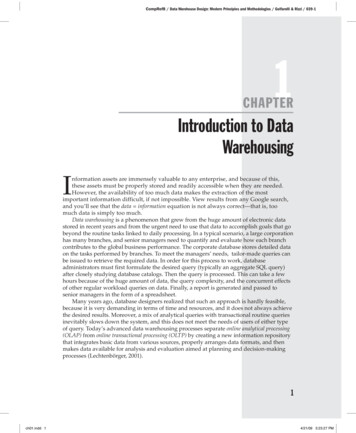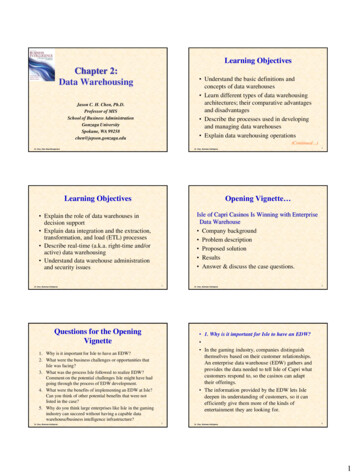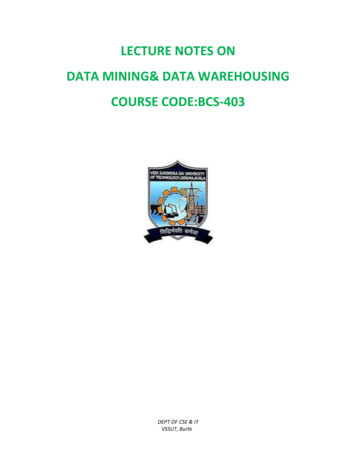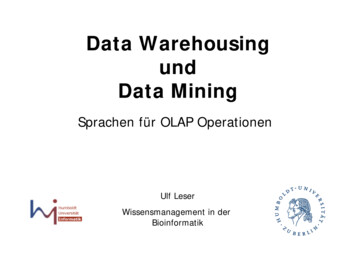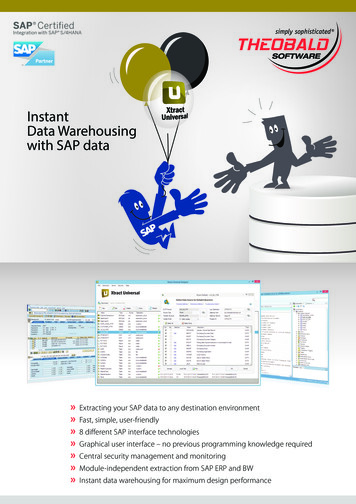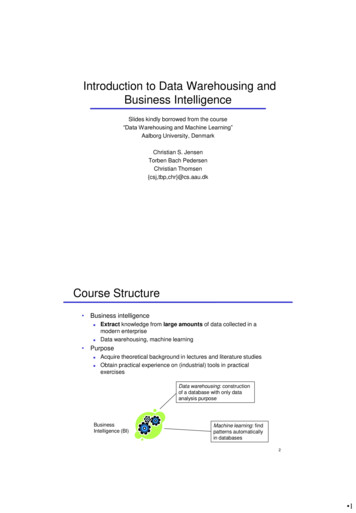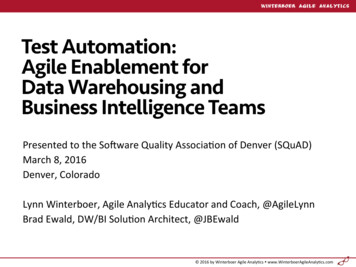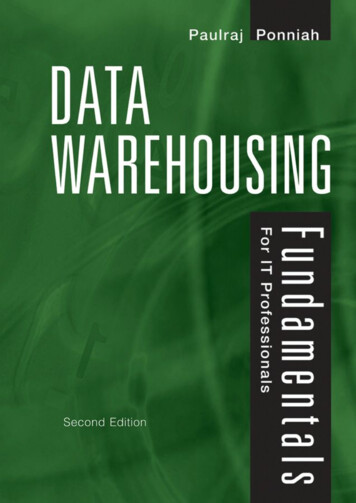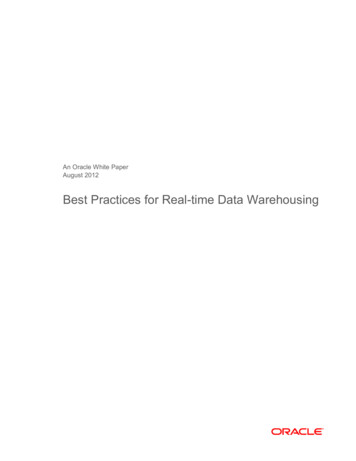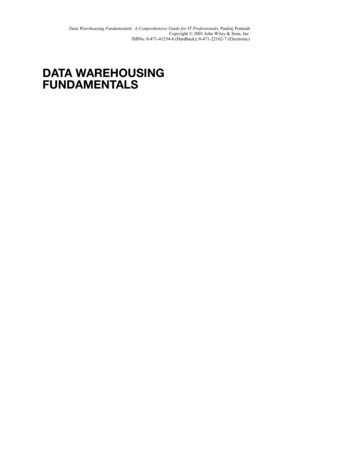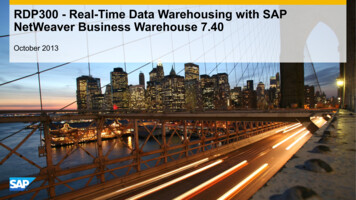
Transcription
Chapter 19. Data Warehousing and Data MiningTable of contents Objectives Context General introduction to data warehousing– What is a data warehouse?– Operational systems vs. data warehousing systems Operational systems Data warehousing systems– Differences between operational and data warehousing systems– Benefits of data warehousing systems Data warehouse architecture– Overall architecture– The data warehouse– Data transformation– Metadata– Access tools Query and reporting tools Application development tools Executive information systems (EIS) tools OLAP Data mining tools– Data visualisation– Data marts– Information delivery system Data warehouse blueprint– Data architecture Volumetrics Transformation Data cleansing Data architecture requirements– Application architecture Requirements of tools– Technology architecture Star schema design– Entities within a data warehouse Measure entities Dimension entities Category detail entities– Translating information into a star schema Data extraction and cleansing– Extraction specifications– Loading data– Multiple passes of data1
– Staging area– Checkpoint restart logic– Data loadingData warehousing and data miningGeneral introduction to data mining– Data mining concepts– Benefits of data miningComparing data mining with other techniques– Query tools vs. data mining tools– OLAP tools vs. data mining tools– Website analysis tools vs. data mining tools– Data mining tasks– Techniques for data mining– Data mining directions and trendsData mining process– The process overview– The process in detail Business objectives determination Data preparation· Data selection· Data pre-processing· Data transformation Data mining Analysis of results Assimilation of knowledgeData mining algorithms– From application to algorithm– Popular data mining techniques Decision trees Neural networks Supervised learning· Preparing data Unsupervised learning - self-organising map (SOM)Discussion topicsObjectivesAt the end of this chapter you should be able to: Distinguish a data warehouse from an operational database system, andappreciate the need for developing a data warehouse for large corporations. Describe the problems and processes involved in the development of a datawarehouse. Explain the process of data mining and its importance.2
Understand different data mining techniques.ContextRapid developments in information technology have resulted in the constructionof many business application systems in numerous areas. Within these systems,databases often play an essential role. Data has become a critical resource inmany organisations, and therefore, efficient access to the data, sharing the data,extracting information from the data, and making use of the information stored,has become an urgent need. As a result, there have been many efforts on firstlyintegrating the various data sources (e.g. databases) scattered across differentsites to build a corporate data warehouse, and then extracting information fromthe warehouse in the form of patterns and trends.A data warehouse is very much like a database system, but there are distinctionsbetween these two types of systems. A data warehouse brings together theessential data from the underlying heterogeneous databases, so that a user onlyneeds to make queries to the warehouse instead of accessing individual databases.The co-operation of several processing modules to process a complex query ishidden from the user.Essentially, a data warehouse is built to provide decision support functions foran enterprise or an organisation. For example, while the individual data sourcesmay have the raw data, the data warehouse will have correlated data, summaryreports, and aggregate functions applied to the raw data. Thus, the warehouseis able to provide useful information that cannot be obtained from any individual databases. The differences between the data warehousing system andoperational databases are discussed later in the chapter.We will also see what a data warehouse looks like – its architecture and otherdesign issues will be studied. Important issues include the role of metadata aswell as various access tools. Data warehouse development issues are discussedwith an emphasis on data transformation and data cleansing. Star schema, apopular data modelling approach, is introduced. A brief analysis of the relationships between database, data warehouse and data mining leads us to the secondpart of this chapter - data mining.Data mining is a process of extracting information and patterns, which are previously unknown, from large quantities of data using various techniques rangingfrom machine learning to statistical methods. Data could have been stored infiles, Relational or OO databases, or data warehouses. In this chapter, we willintroduce basic data mining concepts and describe the data mining process withan emphasis on data preparation. We will also study a number of data miningtechniques, including decision trees and neural networks.We will also study the basic concepts, principles and theories of data warehousing and data mining techniques, followed by detailed discussions. Both3
theoretical and practical issues are covered. As this is a relatively new andpopular topic in databases, you will be expected to do some extensive searching,reading and discussion during the process of studying this chapter.General introduction to data warehousingIn parallel with this chapter, you should read Chapter 31, Chapter 32 and Chapter 34 of Thomas Connolly and Carolyn Begg, “Database Systems A PracticalApproach to Design, Implementation, and Management”, (5th edn.).What is a data warehouse?A data warehouse is an environment, not a product. The motivation for building a data warehouse is that corporate data is often scattered across differentdatabases and possibly in different formats. In order to obtain a complete pieceof information, it is necessary to access these heterogeneous databases, obtainbits and pieces of partial information from each of them, and then put togetherthe bits and pieces to produce an overall picture. Obviously, this approach(without a data warehouse) is cumbersome, inefficient, ineffective, error-prone,and usually involves huge efforts of system analysts. All these difficulties deterthe effective use of complex corporate data, which usually represents a valuableresource of an organisation.In order to overcome these problems, it is considered necessary to have an environment that can bring together the essential data from the underlying heterogeneous databases. In addition, the environment should also provide facilitiesfor users to carry out queries on all the data without worrying where it actually resides. Such an environment is called a data warehouse. All queries areissued to the data warehouse as if it is a single database, and the warehousemanagement system will handle the evaluation of the queries.Different techniques are used in data warehouses, all aimed at effective integration of operational databases into an environment that enables strategic useof data. These techniques include Relational and multidimensional databasemanagement systems, client-server architecture, metadata modelling and repositories, graphical user interfaces, and much more.A data warehouse system has the following characteristics: It provides a centralised utility of corporate data or information assets. It is contained in a well-managed environment. It has consistent and repeatable processes defined for loading operationaldata. It is built on an open and scalable architecture that will handle futureexpansion of data.4
It provides tools that allow its users to effectively process the data intoinformation without a high degree of technical support.A data warehouse is conceptually similar to a traditional centralised warehouseof products within the manufacturing industry. For example, a manufacturingcompany may have a number of plants and a centralised warehouse. Differentplants use different raw materials and manufacturing processes to manufacturegoods. The finished products from the plants will then be transferred to andstored in the warehouse. Any queries and deliveries will only be made to andfrom the warehouse rather than the individual plants.Using the above analogy, we can say that a data warehouse is a centralised placeto store data (i.e. the finished products) generated from different operationalsystems (i.e. plants). For a big corporation, for example, there are normallya number of different departments/divisions, each of which may have its ownoperational system (e.g. database). These operational systems generate data dayin and day out, and the output from these individual systems can be transferredto the data warehouse for further use. Such a transfer, however, is not just asimple process of moving data from one place to another. It is a process involvingdata transformation and possibly other operations as well. The purpose isto ensure that heterogeneous data will conform to the same specification andrequirement of the data warehouse.Building data warehouses has become a rapidly expanding requirement for mostinformation technology departments. The reason for growth in this area stemsfrom many places: With regard to data, most companies now have access to more than 20years of data on managing the operational aspects of their business. With regard to user tools, the technology of user computing has reacheda point where corporations can now effectively allow the users to navigate corporation databases without causing a heavy burden to technicalsupport. With regard to corporate management, executives are realising that theonly way to sustain and gain an advantage in today’s economy is to betterleverage information.Operational systems vs. data warehousing systemsBefore we proceed to detailed discussions of data warehousing systems, it isbeneficial to note some of the major differences between operational and datawarehousing systems.Operational systems5
Operational systems are those that assist a company or an organisation in itsday-to-day business to respond to events or transactions. As a result, operational system applications and their data are highly structured around theevents they manage. These systems provide an immediate focus on businessfunctions and typically run in an online transaction processing (OLTP) computing environment. The databases associated with these applications are requiredto support a large number of transactions on a daily basis. Typically, operational databases are required to work as fast as possible. Strategies for increasingperformance include keeping these operational data stores small, focusing thedatabase on a specific business area or application, and eliminating databaseoverhead in areas such as indexes.Data warehousing systemsOperational system applications and their data are highly structured aroundthe events they manage. Data warehouse systems are organised around thetrends or patterns in those events. Operational systems manage events andtransactions in a similar fashion to manual systems utilised by clerks withina business. These systems are developed to deal with individual transactionsaccording to the established business rules. Data warehouse systems focus onbusiness needs and requirements that are established by managers, who needto reflect on events and develop ideas for changing the business rules to makethese events more effective.Operational systems and data warehouses provide separate data stores. Adata warehouse’s data store is designed to support queries and applications fordecision-making. The separation of a data warehouse and operational systemsserves multiple purposes: It minimises the impact of reporting and complex query processing onoperational systems. It preserves operational data for reuse after that data has been purgedfrom the operational systems. It manages the data based on time, allowing the user to look back and seehow the company looked in the past versus the present. It provides a data store that can be modified to conform to the way theusers view the data. It unifies the data within a common business definition, offering one version of reality.A data warehouse assists a company in analysing its business over time. Usersof data warehouse systems can analyse data to spot trends, determine problemsand compare business techniques in a historical context. The processing thatthese systems support include complex queries, ad hoc reporting and static reporting (such as the standard monthly reports that are distributed to managers).6
The data that is queried tends to be of historical significance and provides itsusers with a time-based context of business processes.Differences between operational and data warehousing systemsWhile a company can better manage its primary business with operational systems through techniques that focus on cost reduction, data warehouse systemsallow a company to identify opportunities for increasing revenues, and therefore,for growing the business. From a business point of view, this is the primary wayto differentiate these two mission-critical systems. However, there are manyother key differences between these two types of systems. Size and content: The goals and objectives of a data warehouse differgreatly from an operational environment. While the goal of an operationaldatabase is to stay small, a data warehouse is expected to grow large – tocontain a good history of the business. The information required to assistus in better understanding our business can grow quite voluminous overtime, and we do not want to lose this data. Performance: In an operational environment, speed is of the essence.However, in a data warehouse, some requests – ‘meaning-of-life’ queries– can take hours to fulfil. This may be acceptable in a data warehouseenvironment, because the true goal is to provide better information, orbusiness intell
from machine learning to statistical methods. Data could have been stored in files, Relational or OO databases, or data warehouses. In this chapter, we will introduce basic data mining concepts and describe the data mining process with an emphasis on data preparation. We will also study a number of data mining techniques, including decision .
